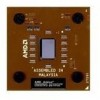AMD AXDA3200DKV4E Data Sheet - Page 95
Appendix A - Thermal Diode Calculations, AMD Athlon™ XP Processor Model 10 Data Sheet - spec
 |
View all AMD AXDA3200DKV4E manuals
Add to My Manuals
Save this manual to your list of manuals |
Page 95 highlights
26237C-May 2003 Preliminary Information AMD Athlon™ XP Processor Model 10 Data Sheet The formulas in Equation (3) and Equation (4) can be used to calculate the temperature offset for temperature sensors that do not employ series resistance cancellation. The result is added to the value measured by the temperature sensor. Contact the vendor of the temperature sensor being used for the value of nf,TS. Refer to the document, On-Die Thermal Diode Characterization, order# 25443, for further details. Equation (3) shows the equation for calculating the lumped ideality factor (nf, lumped) in sensors that do not employ series resistance cancellation. nf, lumped = nf, actual R----T---⋅---(--I--h--i-g--h--------I---l-o--w (3) -kq ( Td ie, sp ec + 273.15) ⋅ ln I-I--hl-oi--gw-h Equation (4) shows the equation for calculating temperature offset (Toffset) in sensors that do not employ series resistance cancellation. T offset = ( Tdie, spec + 273.15) ⋅ 1 - n----fn-,-l-fu-,-mT--Sp--e-d (4) Equation (5) is the temperature offset for temperature sensors that utilize series resistance cancellation. Add the result to the value measured by the temperature sensor. Note that the value of nf,TS in Equation (5) may not equal the value used in Equation (4). T offset = ( Tdie, spec + 273.15) ⋅ 1 - n----fn-,-a-f-,c-T-t-uS--a--l (5) Appendix A - Thermal Diode Calculations 83















